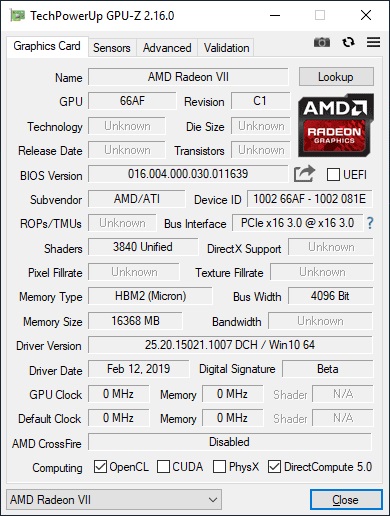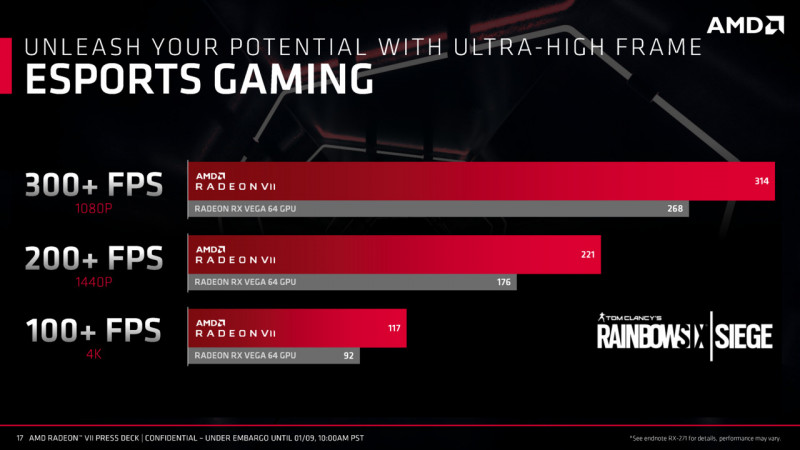Radeon VII

The Radeon VII was AMD's first graphics card based on the Vega 20 architecture and featured the innovative HBM2 manufacturing technology. This product was announced at CES 2019 and hit the market on February 7, 2019. In this article, we'll take a look at the design, architecture, specifications, and performance of the Radeon VII, as well as lay out some interesting facts about the graphics card.
Design and Architecture: The Radeon VII is based on the Vega 20 architecture, manufactured in a 7nm process. It was the first AMD graphics card to be produced using this process, allowing the company to reduce power consumption and increase performance over previous generations. Vega 20 has 3840 stream processors, 240 texture units and 64 ROP units.

The main feature of the Radeon VII was the use of 16 GB HBM2 (High Bandwidth Memory 2) memory. This was AMD's decision to compete with NVIDIA, which used GDDR6 memory in their products. HBM2 allowed for high throughput (1 TB/s) in a compact and energy efficient printed circuit assembly.
Characteristics:
- 3840 stream processors
- 240 texture blocks
- 64 ROP blocks
- GPU base frequency: 1400 MHz
- Boost GPU frequency: 1750 MHz
- Memory: 16GB HBM2
- Memory bus: 4096-bit
- Memory Bandwidth: 1TB/s
- TDP: 300W
Pricing: At the time of announcement, the recommended price for the Radeon VII was $699. Within a short time after the release of the video card on the market, prices fluctuated depending on the store and region.
Gaming Performance: The Radeon VII offered competitive performance comparable to the NVIDIA GeForce RTX 2080. At 1440p and 4K, the graphics card delivered excellent results, especially in games optimized for the Vega architecture. In some games, the Radeon VII outperformed the GeForce RTX 2080, while in others it lost, but the difference was negligible.
With an impressive 16GB of HBM2 VRAM, the Radeon VII can handle high-detailed games and busy scenes with ease. This caught the attention of users involved in professional rendering, video editing and content creation.
Interesting Facts:
-
The Radeon VII was AMD's first graphics card to be built on the 7nm process, enabling it to reduce power consumption and increase performance over previous generations.
-
HBM2 memory was used in the Radeon VII instead of the traditional GDDR6, which allowed for high bandwidth and a compact size of the video card.
-
The Radeon VII was a limited edition and AMD discontinued it a few months after launch. This made the graphics card rarer and more desirable among collectors and enthusiasts.
-
In addition to using the 7nm process technology, Radeon VII also utilized Infinity Fabric technology to simplify and speed up the interaction between the GPU and HBM2 memory.
-
Due to its 16 GB of memory and high performance, Radeon VII has also been popular among cryptocurrency mining users.
Conclusion: The Radeon VII was an interesting product from AMD, offering competitive performance in the high-end graphics card market. It made its mark on history thanks to the use of a 7nm process technology and HBM2 memory. Although the Radeon VII was discontinued a few months after its launch, the graphics card is still remembered by gamers and hardware enthusiasts as one of AMD's most interesting products.
Impact on the graphics card market: Radeon VII has also spurred innovation in the graphics card market. Despite being a limited edition, the Radeon VII showed off the capabilities of the 7nm process and the benefits of using HBM2 memory. These technologies were subsequently improved and applied in subsequent generations of AMD graphics cards, such as the RDNA and RDNA 2 architecture.
Third-Party Card Manufacturers: In addition to the reference models, graphics card manufacturers such as ASUS, Gigabyte, and Sapphire have released their own versions of the Radeon VII with improved cooling and overclocking potential. This allowed users to choose models with different characteristics and design preferences.
Community and Support: The Radeon VII has captured the attention of the modding and enthusiast community for its performance and overclocking capabilities. Many users have been able to squeeze extra performance out of their graphics cards by applying various overclocking and customization methods. AMD has been actively supporting users with new driver releases and gaming optimizations that have contributed to improving the performance of the Radeon VII throughout its lifecycle.
In conclusion, the Radeon VII was a notable product in the graphics card market and left its mark on AMD's history. This graphics card demonstrated innovative technologies that further led to the development of new architectures and technologies in the graphics card industry.




